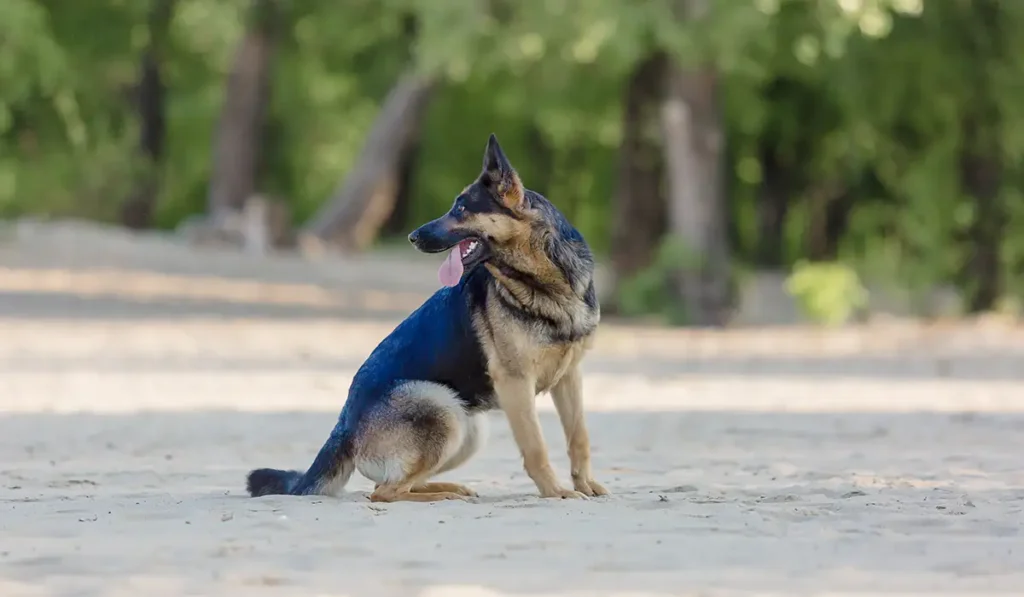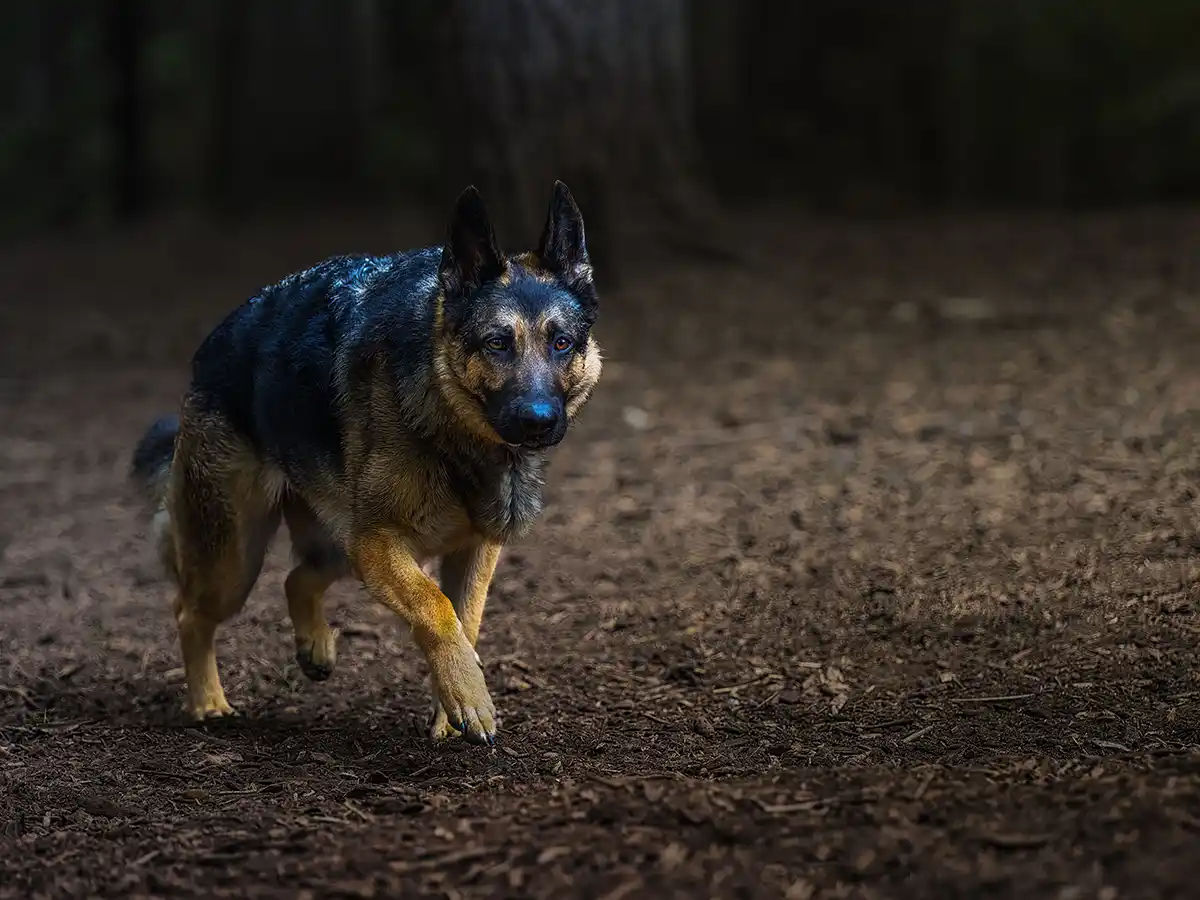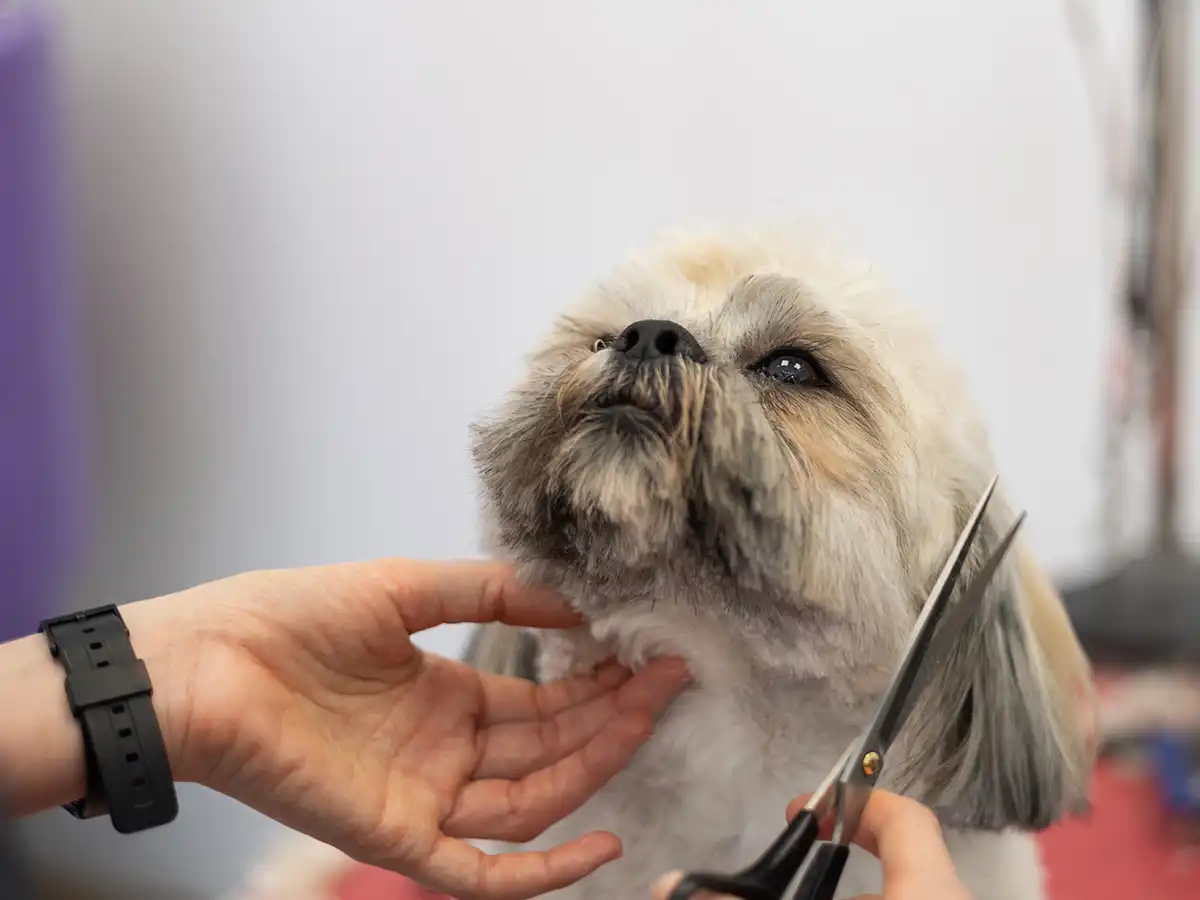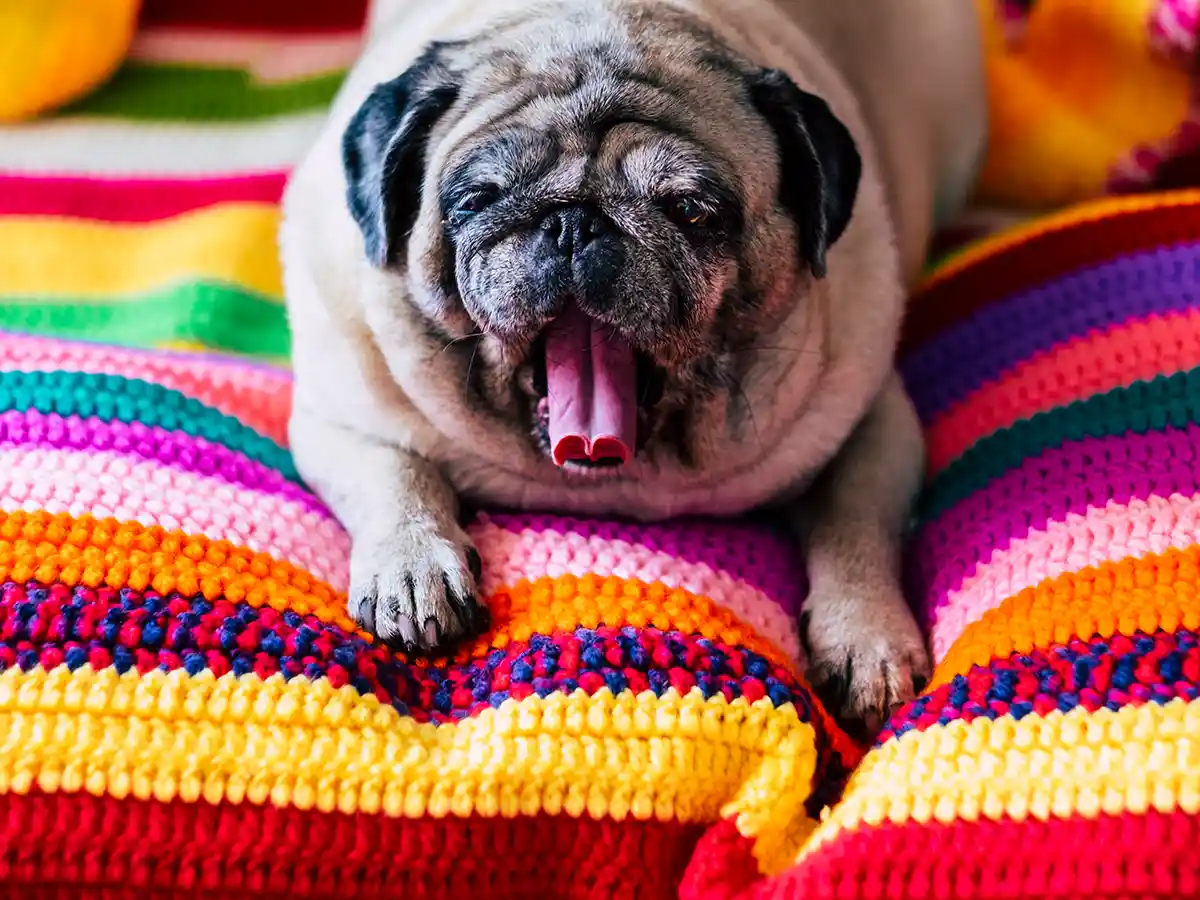Dive into the fascinating world of Blue German Shepherds, a breed surrounded by myths yet full of surprises. These dogs, known for their unique coat color, are often misunderstood. We debunk common misconceptions, revealing their true nature.
Contrary to popular belief, their temperament is shaped by training and environment, not coat color. They are as purebred as their traditional counterparts, with the blue hue stemming from a recessive gene. Health-wise, they are as robust as any German Shepherd, thriving with regular care and love.
We also dispel myths about their rarity and special care needs, showing that while they may be less common, they are not unattainably expensive or high-maintenance. Our article aims to provide a comprehensive understanding of Blue German Shepherds, encouraging readers to look beyond the myths and appreciate these magnificent dogs for their loyalty, intelligence, and playful nature.
What will be covered?
Also read: Male vs Female German Shepherd Lifespan: What to Expect
Debunking Common Myths About Blue German Shepherds
Welcome to the world of Blue German Shepherds! You’re in for a treat as we uncover some myths about these majestic dogs. Blue German Shepherds, with their unique coat color, have been surrounded by myths and tall tales. Let’s set the record straight with some light-hearted facts.
Myth 1: Blue German Shepherds are Aggressive
First up, let’s tackle a biggie. Some say Blue German Shepherds are more aggressive. Spoiler alert: that’s not true! Just like their traditional counterparts, these pups are known for their loyalty and intelligence. Aggression is not a color trait, folks. It’s all about training and socialization. So, if you meet a well-trained Blue Shepherd, expect a friendly wag, not a scary growl.
Myth 2: They Are Not Purebred
Next on the myth-busting list: “Blue German Shepherds aren’t purebred.” This couldn’t be further from the truth. The blue hue comes from a recessive gene. It’s rare, but it’s 100% German Shepherd. These blue beauties are as purebred as their black and tan siblings. Remember, color variations are natural in many breeds. It’s like having different hair colors in humans – normal!
Myth 3: Special Health Issues
Let’s talk health. A common myth whispers that Blue German Shepherds have more health problems. The reality? Their health risks are similar to any German Shepherd. Of course, regular vet visits are vital to keeping any pup healthy. Don’t let the blue coat fool you; these dogs are robust. Just give them the care and love they deserve, and they’ll thrive.
Myth 4: They Are Rare and Expensive
“Blue German Shepherds are incredibly rare and expensive.” Well, they are rarer than the standard colors, but not unattainably so. Prices can vary, like with any pet. But it’s not just about the color. Things like lineage, breeder reputation, and health play more significant roles in pricing. So, if you’re dreaming of a blue buddy, don’t let the myth of exorbitant prices stop you.
Myth 5: Different Temperament
“Some say Blue German Shepherds have a different temperament.” Here’s the deal: temperament is more about upbringing than coat color. A Blue German Shepherd raised in a loving, positive environment will be just as sweet and loyal as any other. They love to play, learn, and please their owners. It’s all about how you raise and train them, not their coat color.
Myth 6: They Require Special Care
Last but not least is the myth that Blue German Shepherds need special care. Here’s the truth – they need the same care as any German Shepherd. Regular grooming, exercise, and a healthy diet are all they ask for. Their stunning blue coat doesn’t mean extra work for you. It just means more compliments at the dog park!
In conclusion, Blue German Shepherds are just like their traditionally colored counterparts in most ways. They’re loving and loyal and make fantastic pets. Don’t let myths cloud your judgment. These blue-coated beauties are just waiting to show you how awesome they are. Remember, it’s the love and training you provide that truly makes a difference, not the color of your coat. So, if you’re considering a Blue German Shepherd, go for it! You’re in for a world of joy and companionship.
Understanding the True Nature of Blue Shepherds

Hey there, dog lovers! Let’s dive into the fascinating world of Blue German Shepherds. These dogs are more than their striking coat. Join me as we explore the true nature of these furry friends.
Blue Shepherds: Loyal Companions at Heart
First things first, Blue German Shepherds are incredibly loyal. This trait is a hallmark of the breed. You’ll find that your blue buddy is always by your side through thick and thin. They form strong bonds with their families. It’s like having a furry shadow that loves you unconditionally! Their loyalty isn’t just a trait; it’s a commitment. They’ll be your devoted companion, always ready to offer a paw of support.
Intelligence and Trainability: A Blue Shepherd’s Superpower
If you’re looking for a smart cookie, look no further! Blue German Shepherds are known for their sharp minds. They’re like the Einsteins of the dog world. This makes them highly trainable. From basic commands to complex tricks, they learn quickly. Imagine teaching your dog to fetch the newspaper or play hide and seek. It’s not just fun; it’s a bonding experience. These dogs love mental challenges. So, keep those treats and praise ready!
The Energy and Playfulness of a Blue Shepherd
Now, let’s talk about energy. Blue German Shepherds are full of it! They’re not couch potatoes. These dogs love to play, run, and explore. They’re perfect for active families or anyone who loves outdoor adventures. Think of long walks, hikes, or playing fetch in the park. Their playful nature is contagious. You’ll find yourself laughing and playing along with them. It’s a great way to stay active and have fun together.
A Blue Shepherd’s Protective Instinct
One of the most admirable traits of Blue German Shepherds is their protective instinct. They’re natural guardians. Don’t worry; they’re not overly aggressive. They’re just always alert and ready to keep you safe. It’s like having your bodyguard, but fluffier! They assess situations and act accordingly. If you ever feel uneasy, just look at your blue shepherd. They’re always on watch, ensuring your safety.
The Social Butterfly: Blue Shepherds and Socialization
Blue German Shepherds are quite the social butterflies. They enjoy meeting new people and other dogs. Early socialization is vital. It helps them become well-rounded and friendly. Take them to dog parks or have playdates. It’s a joy to watch them interact and make new friends. They might even teach you a thing or two about socializing!
Emotional Sensitivity: A Blue Shepherd’s Hidden Trait
Here’s something special about Blue German Shepherds: they’re emotionally sensitive. They can sense your mood. Are you feeling down? They’ll be right there, offering comfort. Excited? They’ll share your enthusiasm. This emotional connection is what makes them such great companions. They truly understand and empathize with you. It’s like having a best friend who gets you without words.
Adaptability: Blue Shepherds in Different Environments
Lastly, let’s talk about adaptability. Blue German Shepherds are versatile. They can thrive in various environments. Whether you live in an apartment or have a big backyard, they’ll adjust. Just remember, they need their exercise. So, regular walks and playtime are a must. They’re happy as long as they’re with you and have space to burn off energy.
In conclusion, Blue German Shepherds are loyal, intelligent, playful, and protective. They’re social, emotionally sensitive, and adaptable. These traits make them excellent pets. They’re more than just their stunning blue coat. They’re companions for life, ready to bring joy and adventure into your home. So, if you’re thinking about getting a Blue German Shepherd, go for it! Your new best friend is waiting.
The Genetics Behind the Blue Coat: Science Speaks

Hey there, dog lovers! Ever wondered what makes a Blue German Shepherd so uniquely hued? It’s all in the genes! Let’s dive into the fascinating world of genetics to uncover the mystery behind that gorgeous blue coat. Don’t worry, I’ll keep it simple and fun!
It’s All About the Genes
First off, let’s talk genes. The blue coat of a Blue German Shepherd isn’t about dye or magic; it’s pure science. There’s a specific gene responsible for this color. It’s called the dilution gene, and it works by diluting the traditional black pigment. Think of it like adding water to paint – it lightens the color. This dilution gene turns what would be black into a stunning blue shade.
A Recessive Trait
Here’s a cool fact: the blue coat color is a recessive trait. This means that both parents must carry the gene, even if they’re not blue themselves. If only one parent has the gene, the puppy won’t be blue. It’s like a hidden surprise waiting to pop up! So, when two German Shepherds with this gene have puppies, there’s a chance for Blue German Shepherds. It’s a genetic lottery, and the blue coat is the jackpot!
Not Just a Pretty Color
Now, you might think it’s just about looks, but there’s more. The dilution gene doesn’t just affect coat color. It can also influence the color of the nose and eyes. So, a Blue German Shepherd might have lighter eyes or a bluish tint to their nose. It’s all part of their unique genetic makeup. They’re like the rare gems of the German Shepherd world!
Blue Coat Across Breeds
And it’s not just German Shepherds! The dilution gene appears in other breeds too. From Dobermans to Great Danes, the blue coat pops up in various dog families. It’s a widespread genetic trait but always special. Each blue-coated pup is a testament to the wonder of genetics.
Health and the Blue Coat
A quick word on health: some believe the dilution gene affects it. But here’s the good news. Blue German Shepherds are just as healthy as their standard-colored siblings. The key is responsible breeding. Good breeders pay attention to health, not just coat color. So, your blue buddy can be as fit and happy as any other pup.
Uncovering the Genetic Mystery
So, there you have it. The blue coat of the Blue German Shepherd is a fascinating blend of genetics and nature’s art. It’s a rare and beautiful result of recessive genes at play. But remember, it’s not just about looks. These dogs are as loving, intelligent, and loyal as any German Shepherd. Their blue coat is just the icing on the cake!
In summary, the Blue German Shepherd’s coat color is a beautiful quirk of genetics. It’s a rare and captivating feature that adds to their charm. But at the end of the day, it’s the love and companionship they offer that truly matters. So, whether blue or black, a German Shepherd is a wonderful addition to any family. Let’s appreciate them for all their qualities, blue coats, and beyond!
How to Identify a Purebred Blue German Shepherd

Hey there, dog lovers! Are you curious about how to spot a purebred Blue German Shepherd? It’s not just about the color. Let’s dive into the fun world of identifying these unique pups.
Look at the Coat Color
First things first, the coat. A Blue German Shepherd’s coat isn’t blue, but a fantastic, steely grey. This unique color is due to a dilution gene. It’s like having a black coat that decided to go a bit hipster! But remember, coat color can vary. From light silvery tones to darker slate, they’re all beautiful. And if you’re thinking, “Is that blue or black?” you’re probably looking at a Blue German Shepherd.
Check the Physical Features
Now, let’s talk body language – of the dog, of course! A purebred Blue German Shepherd will have the same features as any standard German Shepherd. Look for a sturdy build, pointed ears standing tall, and that confident, intelligent gaze. These dogs carry themselves with a certain poise. It’s like they know they’ve got the looks and brains. And their eyes? They should be dark and expressive, telling you stories without a single bark.
Ask for Pedigree Papers
When in doubt, go for the paperwork. Pedigree papers are like a dog’s family tree. They trace the lineage back to the great-great-granddoggers. This documentation will confirm if your blue buddy is a purebred. No papers? It’s like trying to trace your ancestry without a DNA test – you can guess, but you can’t be sure. Reputable breeders will always have these papers. It’s their way of saying, “Yes, this is a top-notch Blue German Shepherd!”
Understand the Genetics
Here’s a bit of science for you. The blue color in German Shepherds comes from a recessive gene. Both parents need to carry this gene to produce a blue pup. It’s like winning a genetic lottery! If you’re really into genetics, ask the breeder about the parents’ coat colors. It’s a great conversation starter and shows you’re serious about understanding your future pet.
Behavioural Traits
Now, let’s talk about behavior. Purebred Blue German Shepherds are as intelligent as they come. They’re quick learners and love a good challenge. If the pup you’re eyeing seems eager to engage, loves to play fetch, and responds well to basic commands, you might have a purebred on your hands. Remember, a well-trained dog is a happy dog. And a happy dog makes a happy you!
Health and Wellness
Last but not least, let’s chat about health. Purebred Blue German Shepherds should be robust and active. They love a good run and should have a strong, muscular build. But watch out for common health issues like hip dysplasia. A healthy Blue Shepherd is a joy to be around, so make sure to check for any signs of discomfort or unusual behavior.
In conclusion, identifying a purebred Blue German Shepherd is about more than just admiring that unique coat color. It’s about understanding their physical features, genetics, behavior, and health. And always remember to check those pedigree papers. If you’re lucky enough to bring home a Blue German Shepherd, you’re in for a world of fun. They’re not just pets; they’re loyal friends, ready to add a splash of ‘blue’ to your life!
FAQs
-
Are Blue German Shepherds Aggressive Due to Their Color?
Contrary to some beliefs, the temperament of Blue German Shepherds isn’t determined by their coat color. These dogs are known for their loyalty and intelligence, similar to traditional German Shepherds. Aggression is more about upbringing and training than color.
-
Is the Blue German Shepherd a Purebred Dog?
Yes, Blue German Shepherds are purebred. Their unique blue hue is due to a recessive gene, making them as purebred as their black and tan counterparts. This color variation is a natural occurrence within the breed.
-
Do Blue German Shepherds Have Special Health Issues?
Blue German Shepherds have similar health risks as any other German Shepherd. Their blue coat does not predispose them to additional health problems. Regular veterinary care is essential to maintain their health.
-
Are Blue German Shepherds Rare and Expensive?
While Blue German Shepherds are less common than standard colors, they are not excessively rare or expensive. Factors like lineage, breeder reputation, and overall health influence their price more than their coat color.
-
Does the Blue German Shepherd Require Special Care?
No, Blue German Shepherds do not require special care compared to other German Shepherds. Regular grooming, exercise, and a healthy diet are sufficient for their well-being. Their stunning blue coat doesn’t mean additional care requirements.
-
Can the Temperament of Blue German Shepherds Differ from Other German Shepherds?
The temperament of a Blue German Shepherd is influenced more by its environment and upbringing than by its coat color. A loving, positive environment results in a well-behaved and loyal dog, irrespective of the coat color.
-
How Can I Identify a Purebred Blue German Shepherd?
To identify a purebred Blue German Shepherd, look for typical physical features of German Shepherds, check the coat color for a unique steely grey hue, and ask for pedigree papers. Understanding their genetics and behavior can also help in identification.
-
What Makes the Coat of Blue German Shepherds Unique?
The coat color of Blue German Shepherds is due to a dilution gene, which lightens the traditional black pigment, creating a unique blue or steely grey shade. This is a genetic trait and part of the breed’s natural variation.

Meet Biplab Roy, the passionate voice behind our blog’s delightful tales of furry and feathered companions. As the proud owner of a charming pet shop and a thriving farm, Biplab’s life revolves around the enchanting world of pets. With a heart full of love for animals and a wealth of experience in caring for them, Biplab brings a unique perspective to our community of pet enthusiasts.
Biplab’s journey into the realm of pets began with a deep-seated affection for these lovable creatures. His pet shop isn’t just a business; it’s a sanctuary for pet lovers seeking advice, supplies, and a warm community. From chirpy birds to playful puppies and everything in between, Biplab’s shop is a haven for those who share his passion.
But Biplab’s connection with animals doesn’t end at the pet shop door. His bustling farm is a testament to his commitment to providing a happy and healthy life for all creatures under his care. Whether it’s the joyous barks of dogs or the gentle clucking of hens, Biplab’s farm is a symphony of harmonious coexistence.
Through the pages of our blog, Biplab shares his insights, anecdotes, and valuable tips on pet care, drawing from his hands-on experience as a devoted pet owner and caretaker. His articles are a delightful blend of heartwarming stories, practical advice, and a genuine love for the diverse world of pets.
Join Biplab on this journey as he explores the ups and downs of pet ownership, offering a warm and knowledgeable companion for fellow pet enthusiasts. Whether you’re a seasoned pet owner or considering bringing a new furry friend into your life, Biplab’s words are sure to resonate and inspire, making your journey into the wonderful world of pets even more rewarding.







1 Comment
[…] that’s more like ours. This means they don’t lose it as much as, say, a Labrador or a German Shepherd. These popular breeds have fur that sheds more, like leaves falling in […]